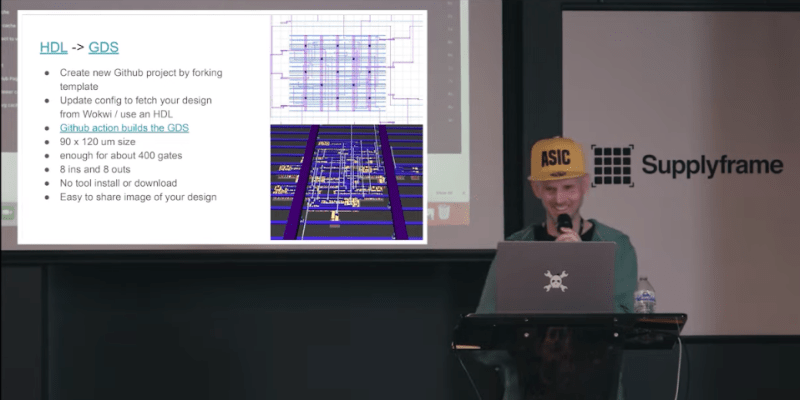
Not that long ago, rolling your own printed circuit boards was difficult, time-consuming and expensive. But thanks to an army of cheap, online manufacturing services as well as high-quality free design software, any hobbyist can now make boards to rival those made by pros. A similar shift might be underway when it comes to chip design: affordable manufacturing options and a set of free software tools are slowly bringing custom chips into the realm of hackers and hobbyists. One of those working hard to democratize chip design is [Matt Venn], who’s been telling us all about his current big project, called Tiny Tapeout, in his talk at Remoticon 2022.
[Matt]’s quest to bring IC design to the masses started in 2020, when the first open-source compatible Process Design Kit (PDK) was released to the public. A PDK is a collection of files, normally only available under strict non-disclosure agreements, that describe all the features of a specific chip manufacturing process and enable you to make a design. With this free PDK in hand and a rag-tag collection of free software tools, [Matt] set out to design his first chip, a VGA clock, which he taped out (released to manufacturing) in July 2020.
Building on this experience, [Matt] wrote a complete beginner’s guide to chip design, called the Zero to ASIC course. To give students the opportunity to put this theory into practice, he also organized a multi-project wafer: a single manufacturing run that pools multiple designs in order to split the cost. This turned out to be hugely popular, and [Matt] has so far coordinated seven of these MPWs, each with loads of interesting designs.

However, even with a free PDK, open-source tools and a detailed course explaining the way, designing properly functioning chips is still very difficult. [Matt]’s next big project, called Tiny Tapeout, therefore aims to make chip design so easy that even a child can do it. It does this by integrating all the required tools into a single web-based application and offering a cheap manufacturing option to go with it.
The web tool is based on WokWi by [Uri Shaked]. WokWi is a browser-based circuit simulation tool, originally developed for Arduino programming, which [Matt] and [Uri] turned into a logic design and simulation tool for chip design. Once you’ve designed your chip’s logic behavior, you can link the design into a GitHub repository where a script will then turn it into a complete chip layout. You can view the layout and even zoom around the transistors in a full 3D view, seeing exactly what the final result would look like under a microscope.
On the manufacturing side, [Matt] provides each project with a chip area of 90 by 120 microns, enough for around 400 logic gates. Each chip gets eight inputs and eight outputs, which can operate at clock frequencies of up to 15 kHz. This might not seem like much, but the project’s trial run yielded several impressive projects, including simple counters and adders but also a 4-bit CPU and even a 9-LUT FPGA.

There’s space on the chip for about 500 different designs, all of which will be present in all manufactured chips – you can choose which design is active by selecting the ID of that design using DIP switches on the PCB. A comprehensive datasheet will list the contents of each single design, so there’s plenty left to play with even after you’ve checked out your own work.
[Matt] also has lots of things left to do: he’s aiming to add analog and RF functionality to the current design flow, which would enable far more versatile designs that can connect to sensors and drive high-speed data buses. One tool that will help in teaching analog design is SiliWiz, another web-based simulation tool he’s been working on that lets you play with on-chip transistor layouts and see their electrical behavior in real time.
We can’t help but be impressed by [Matt]’s tireless work to make chip design available to anyone, and we’re looking forward to the next, even more powerful generation of Tiny Tapeout. Perhaps one day, submitting a GDS file to a fab will seem just as ordinary as sending Gerbers to a PCB shop is today.
No comments:
Post a Comment